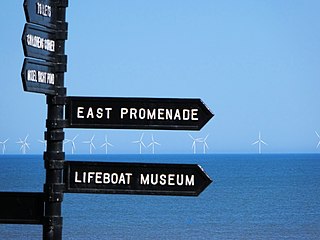
Harland & Wolff is a shipyard in Belfast, Northern Ireland. It specialises in ship repair, conversion and offshore construction. Harland & Wolff is famous for having built the majority of the ocean liners for the White Star Line. Well-known ships built by Harland & Wolff include: the Olympic-class trio – RMS Titanic, RMS Olympic and HMHS Britannic; the Royal Navy's HMS Belfast; Royal Mail Line's Andes; Shaw Savill's Southern Cross; Union-Castle's RMS Pendennis Castle; and P&O's Canberra. Harland and Wolff's official history, Shipbuilders to the World, was published in 1986.

Tidal power or tidal energy is harnessed by converting energy from tides into useful forms of power, mainly electricity using various methods.

A wind farm or wind park, also called a wind power station or wind power plant, is a group of wind turbines in the same location used to produce electricity. Wind farms vary in size from a small number of turbines to several hundred wind turbines covering an extensive area. Wind farms can be either onshore or offshore.

SBM Offshore N.V. is a Dutch-based global group of companies selling systems and services to the offshore oil and gas industry. Its constituent companies started their offshore activities in the early 1950s and SBM subsequently became a pioneer in single buoy moorings (SBM) systems. The firm leases and operates Floating Production Storage and Offloading vessels, and is involved in the design and engineering, construction, installation, operation and maintenance of floating production equipment for the offshore Oils and Gas industry. It is a main board listed company on the Euronext Amsterdam stock exchange and has been a member of the AEX index since 2003. It has been engulfed by a massive corruption scandal in Brazil.

The China Shipbuilding Industry Corporation (CSIC) was one of the two largest shipbuilding conglomerates in China, the other was the China State Shipbuilding Corporation (CSSC). It was formed by the Government of the People's Republic of China on 1 July 1999 from companies spun off from CSSC, and is 100% owned by State-owned Assets Supervision and Administration Commission (SASAC) of State Council. Headquartered in Beijing, the CSIC handles shipbuilding activities in the north and the west of China, while the China State Shipbuilding Corporation (CSSC) deals with those in the east and the south of the country.

The production of renewable energy in Scotland is a topic that has come to the fore in technical, economic, and political terms during the opening years of the 21st century. The natural resource base for renewable energy is high by European, and even global standards, with the most important potential sources being wind, wave, and tide. Renewables produced the equivalent of 97.4% of Scotland's electricity consumption in 2020, mostly from the country's wind power.
Subsea is fully submerged ocean equipment, operations or applications, especially when some distance offshore, in deep ocean waters, or on the seabed. The term is frequently used in connection with oceanography, marine or ocean engineering, ocean exploration, remotely operated vehicle (ROVs) autonomous underwater vehicles (AUVs), submarine communications or power cables, seafloor mineral mining, oil and gas, and offshore wind power.
The European Marine Energy Centre (EMEC) Ltd is a UKAS accredited test and research centre focusing on wave and tidal power development based in the Orkney Islands, UK. The Centre provides developers with the opportunity to test full-scale grid-connected prototype devices in unrivalled wave and tidal conditions.

Sheringham Shoal Offshore Wind Farm is a Round 2 wind farm in North Sea off the coast of Norfolk. A lease for use of the sea bed was obtained in 2004 by Scira Offshore Energy, the development gained offshore planning consent in 2008, and was constructed 2009–2011, being officially opened in 2012.

A floating wind turbine is an offshore wind turbine mounted on a floating structure that allows the turbine to generate electricity in water depths where fixed-foundation turbines are not feasible. Floating wind farms have the potential to significantly increase the sea area available for offshore wind farms, especially in countries with limited shallow waters, such as Japan, France and US West coast. Locating wind farms further offshore can also reduce visual pollution, provide better accommodation for fishing and shipping lanes, and reach stronger and more consistent winds.

TIVMPI Resolution is a wind turbine installation vessel deployed to install turbines at offshore wind farms. It was the first self-elevating Turbine Installation Vessel in the world. She can raise herself on her six legs between 3 metres (10 ft) and 46 metres (151 ft) above the sea.

Offshore wind power or offshore wind energy is the generation of electricity through wind farms in bodies of water, usually at sea. There are higher wind speeds offshore than on land, so offshore farms generate more electricity per amount of capacity installed. Offshore wind farms are also less controversial than those on land, as they have less impact on people and the landscape.
GE Power's offshore wind business is a joint venture with Alstom, created in 2015 when most of that company's other electrical power and generation assets were acquired. GE's stake in the joint venture is 50 % plus 1 share.
GE Wind Energy is a branch of GE Renewable Energy, a subsidiary of General Electric. The company manufactures and sells wind turbines to the international market. In 2018, GE was the fourth largest wind turbine manufacturer in the world.

A tidal stream generator, often referred to as a tidal energy converter (TEC), is a machine that extracts energy from moving masses of water, in particular tides, although the term is often used in reference to machines designed to extract energy from run of river or tidal estuarine sites. Certain types of these machines function very much like underwater wind turbines, and are thus often referred to as tidal turbines. They were first conceived in the 1970s during the oil crisis.

Suction caissons are a form of fixed platform anchor in the form of an open bottomed tube embedded in the sediment and sealed at the top while in use so that lifting forces generate a pressure differential that holds the caisson down. They have a number of advantages over conventional offshore foundations, mainly being quicker to install than deep foundation piles and being easier to remove during decommissioning. Suction caissons are now used extensively worldwide for anchoring large offshore installations, like oil platforms, offshore drillings and accommodation platforms to the seafloor at great depths. In recent years, suction caissons have also seen usage for offshore wind turbines in shallower waters.

A wind turbine installation vessel (WTIV) is a vessel specifically designed for the installation of offshore wind turbines. There were 16 vessels in 2020.

Trump International Golf Club Scotland Ltd v Scotland [2015] UKSC 74 is a 2015 judgment of the Supreme Court of the United Kingdom on the authority of the Scottish government to allow windfarm applications, under the Electricity Act 1989. It is relevant for UK enterprise law and the regulation of UK wind power.
Seawind Ocean Technology B.V., a Netherlands based company, is a manufacturer (OEM) of integrated floating wind turbine and green hydrogen systems. Seawind is developing two-bladed floating wind turbines suitable for installation in all seas, including hurricane regions and ultra-deep waters. Founded on original research and development work by NASA, Hamilton Standard, Enel, and Aeritalia; Seawind's offshore wind power turbines with integrated foundations have been patented, proven at 1.5 MW, and achieved Type D DNV certification in December 2019. The company is now planning the launch of its Seawind 6 demonstrator to be followed by the pre-series Seawind 12, a project earmarked for installation as early as 2024-25 that seeks to obtain DNV's highest certification level.

Royal IHC or Koninklijke IHC, previously IHC Holland (1943–1995), IHC Holland Merwede (1995–2005) and IHC Merwede (2005–2014) is a Dutch shipbuilding company with headquarters in Kinderdijk. It focuses on the development, design and construction of ships for the dredging and offshore industries.















